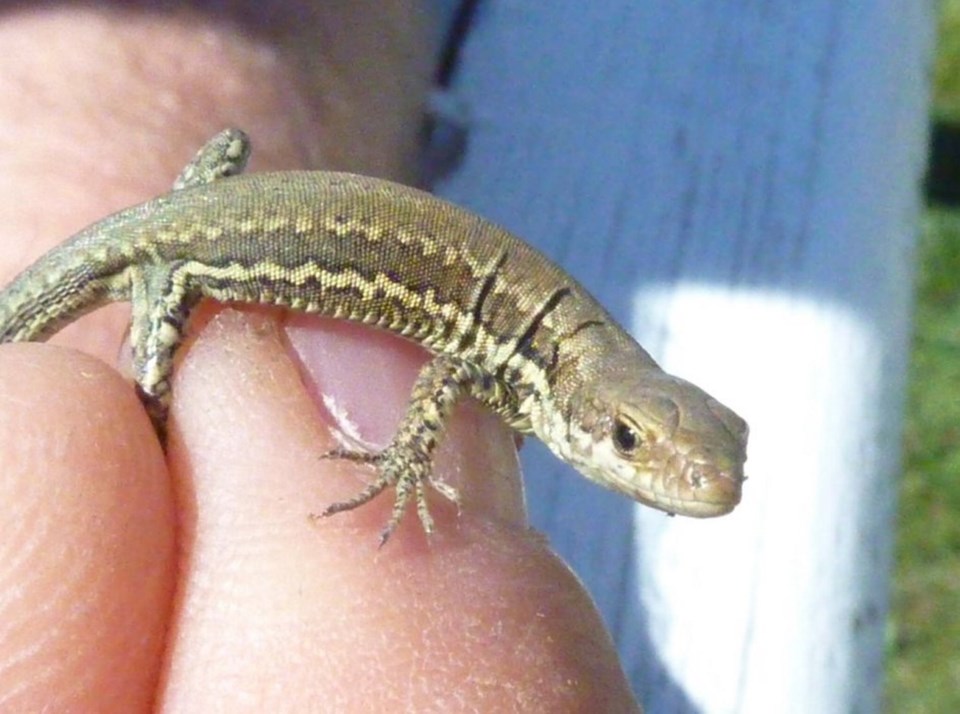Beautiful day, perfect for golfing or fishing or, as was suggested with more force than necessary, working in the yard.
So, I was outside, channelling my inner Chesnut when, out of nowhere, this little lizard sprang straight up in front of my face — boing! — as though shot from a jack-in-the-box. Somewhere, a little girl screamed. Wait, no, it was me.
In my defence, the critter was creepy: Scaly skin, blank reptilian stare, tiny hands.
I poked my head inside the house: “Did you put LSD in the lemonade?”
“No.”
“Then Donald Trump is in the garden.”
“No,” she said. “It’s a European wall lizard.”
A what? A European wall lizard, native to northern Italy. They’re an invasive species — one whose rapid expansion throughout Greater Victoria is making scientists antsy.
“They’re really spreading fast and furiously,” says Gavin Hanke, curator of vertebrate zoology at the Royal B.C. Museum.
The problem is, nobody knows what that means. There hasn’t been enough research to determine whether they are harmful.
Good or bad, it seems we’re stuck with them. “We’ve got a massive population,” says Hanke. “It will be very hard to eradicate those lizards now.”
Instead, the focus is on containing them. The precautionary principle applies: “It’s easier to not release them than to mop up later,” Hanke says.
At a guesstimate, there might be 200,000 wall lizards around Greater Victoria — pretty wild when you consider the roots of the story. Accepted wisdom says they are descended from a dozen animals that either escaped or were freed when Rudy’s Pet Park, a private zoo on Durrance Road south of Brentwood Bay, closed in 1970.
“The whole Peninsula is now crawling with them,” Hanke says.
He has been plotting their spread elsewhere in the region: Triangle Mountain, James Bay, Gordon Head, the Gorge. In some cases colonies have spread until they joined together. Hanke knows of wall lizards west of Hillside mall, at Moss Rocks in Fairfield, near Ogden Point, by the Saanich works yard, even as far out as Rocky Point Road in Metchosin. “They’re really moving around.”
Wall lizards have been found in Mill Bay, Shawnigan Lake, Nanaimo, Denman Island and as far north as Campbell River. They have even been spotted in North Vancouver, bad news for those who hoped to keep them off the mainland.
Good luck with that: At least two lizards made their way to Osoyoos in a load of Vancouver Island wine grapes last year. One was caught and died in captivity. The other was road kill. Hanke hopes that’s all there were.
That sort of stowaway joy ride is common. They travel in hay bales, plant pots, firewood or livestock trailers. Not that big a deal if it’s a male, but a problem if it’s an egg-laying female.
They disperse naturally (colonies spread 40 to 70 metres a year as the young try to get away from their cannibalistic elders) but what’s really troubling is when people move them on purpose. One guy was ratted out by his ex-wife for playing Johnny Lizardseed, intentionally releasing wall lizards in the belief that doing so would save native alligator lizards by giving cats something else to attack instead. “His heart was in the right place,” Hanke says. Dodgy science, though.
Some wonder if the newcomers will actually drive out the alligator lizards (though Hanke notes that the natives seem to be co-existing just fine with the wall lizards he found on Mount Tolmie this spring). They also wonder if wall lizards might compete for egg-laying space with (or even eat) sharp-tailed snakes (harmless, indigenous to Vancouver Island, and in need of help).
Hanke hopes to get some answers this summer by analyzing wall lizards’ stomach contents to see what they have been eating.
Have to catch them first, though. Growing to the length of your hand, wall lizards are amazingly fast and nimble. If you’re quick enough to catch one, you might find yourself holding nothing but a shedded tail.
They’re fairly easy to tell apart from alligator lizards. The latter are copper-coloured or grey, while wall lizards have a green tinge to their skin. The scales on the backs of alligator lizards are larger than those of the invaders.
The newcomers’ long toes make them terrific climbers; hence their name.
“Build that wall,” urged the one in my garden. “Make your yard great again.”



